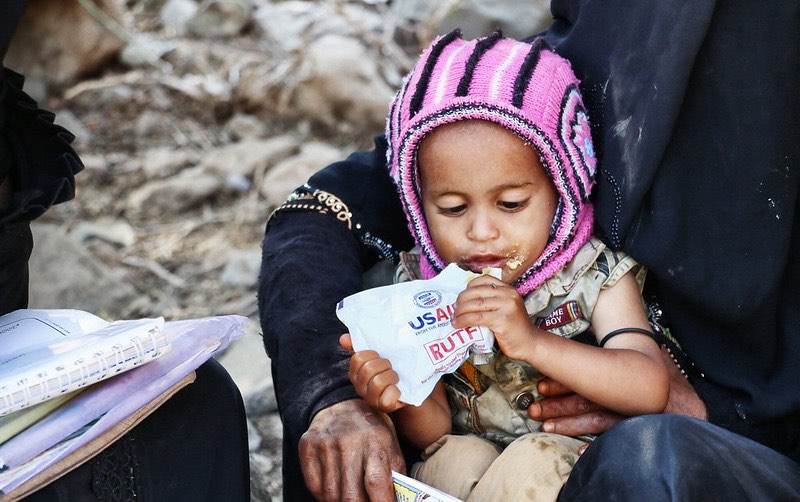For the past three years, the number of people around the world in urgent need of food and nutrition assistance has remained above 100 million, according to the annual Global Report on Food Crises (GRFC). The report aims to provide governments, international organizations, and other stakeholders with the data and analysis needed to respond to and prevent the crises that lead to such massive food-insecure populations. In a first-ever mid-year update to the report, GRFC partners provide a revised look at the severity of current global food crises in terms of the number of acutely food-insecure people, as well as the status of the crisis: Improving, deteriorating, or stable.
Yemen is still home to the world’s worst food security crisis, the report says. It also finds slight improvement in northern Nigeria and South Sudan; a deterioriating situation in Ethiopia; ongoing problems in Sudan; and escalating food insecurity in the Sahel due to conflict.
The report, published by the Food Security Information Network (FSIN) with support from the European Union and USAID, uses the Integrated Food Security Phase Classification (IPC) or the Cadre Harmonisé (CH) systems whenever possible to classify the severity and magnitude of acute food insecurity. Under these systems, populations in Crisis (IPC/CH Phase 3), Emergency (IPC/CH Phase 4) and Catastrophe /Famine (IPC/CH Phase 5) are considered to be in need of urgent food, nutrition, and livelihood support. In countries in which the IPC/CH classification systems are not used, the report calls upon IPC-compatible analyses prepared by FEWS Net, Vulnerability Assessment Committees (VAC), Food Security Cluster (FSC) reports, Humanitarian Needs Overviews (HNO), or the WFP’s Food Security Assessments.
The 2019 GRFC looked at the number of acutely food-insecure people in 2018; the mid-year update provides a look at that number in the first eight months of 2019.
In 2018, of the 113 million people around the world in urgent need of food, nutrition and livelihood assistance (IPC/CH Phase 3 or above), the majority (two-thirds) lived in just eight countries: Yemen, the Democratic Republic of the Congo, Afghanistan, Ethiopia, Syrian Arab Republic, South Sudan, Sudan, and northern Nigeria. Updated data for 2019 was available for six out of these eight countries but only three (Ethiopia, South Sudan, and northern Nigeria) had data comparable with that of 2018.
In Yemen, 15.9 million people, or more than half of the country’s population, were classified as being in need of food, nutrition, or livelihood assistance (IPC/CH Phase 3 or above) in January 2019. Of these, 64,000 were classified as being in Phase 5 (Catastrophe) level food insecurity. The most recent IPC analysis, conducted from July through Sept. 2019, collected data from 29 of the country’s 45 worst-affected districts and found slight improvement due to recent scale-up of assistance efforts coupled with improved seasonal food availability; however, this remains the world’s worst food security crisis. Ongoing active conflict is the main driver of this acute insecurity.
In the Democratic Republic of the Congo, 26% of the population was in need of some type of food, nutrition, or livelihood assistance in the second half of 2019. Around 15.6 million people were in IPC Phase 3 (Crisis) levels of food insecurity, while just below four million faced IPC Phase 4 (Emergency) levels.
Ethiopia has seen a deterioration of the food security situation between 2018 and 2019. The number of people facing acute food insecurity has risen from 8.1 million to 8.5 million. The main driver of this increase in food insecurity has been drought and localized flooding.
In South Sudan between May and June 2019, the number of people in IPC Phase 3 or above levels of food insecurity reached the highest on record (6.96 million or 61% of the population). In addition, as many as 21,000 were expected to see IPC Phase 5 (Catastrophe) food insecurity by the middle of 2019. However, beginning in August, the country’s food security situation saw a slight improvement, with the number of food-insecure people fell by about 5% from August 2018. The improvement seems to have been driven by humanitarian assistance and a slight recovery in market functionality. Despite this improvement, however, many people in South Sudan continue to lack food access and availability as a result of conflict.
In Sudan, economic crisis and political instability have driven an estimated 5.9 million people into acute food insecurity in 2019. This is despite favorable prospects for 2018-2019 food and livestock production in the country.
Northern Nigeria saw a slight decrease in the number of people facing acute food insecurity in 16 states. The number of people in IPC 3 (Crisis) and IPC 4 (Emergency) food insecurity was 5.3 million in June-August 2018 and 5 million in June-August 2019.
Regionally, the mid-year GRFC update reports an escalating crisis in the Sahel as a result of increasing conflict toward the latter half of the year. While this conflict originated in Mali, Niger, and Burkina Faso, its impacts are expected to expand to other countries in the region through population displacement. As displaced people compete with local populations for land, food, and other resources, many in the region will face increasing difficulty accessing food and markets.
Out of the 53 countries and territories included in the 2019 annual report, updated data as of Sept. 2019 was available for 37 countries. Five countries (including Afghanistan and the Syrian Arab Republic) did not have updated estimates available, while eleven (Central African Republic, the Democratic Republic of the Congo, eSwatini, the Gambia, Guinea, Kenya, Mozambique, Pakistan, the Sudan, Yemen and the Zambia) had data incomparable to that of 2018 due to changes in geographical coverage. In the latter case, while the report still conducted analysis of the 2019 data, it was not feasible to provide an accurate estimate of the aggregate peak number of people in need of food, nutrition, and livelihood assistance.
Sara Gustafson is a freelance writer. This post also appears on the Food Security Portal blog.







